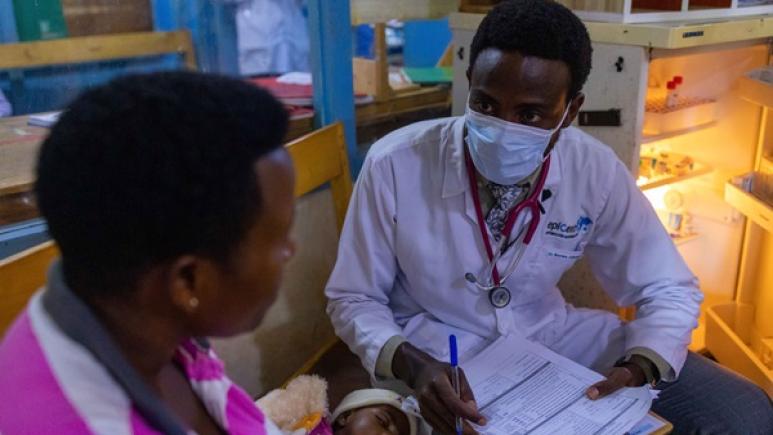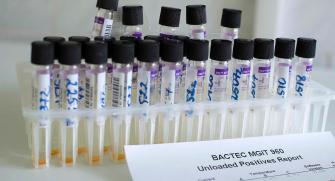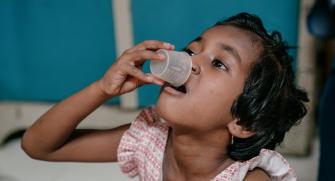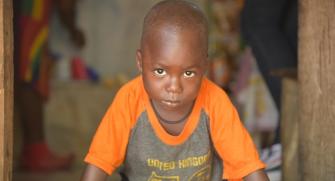Tuberculosis Treatment decision algorithms: promising early data highlight their added value in diagnosing children
TB remains one of the deadliest infectious diseases, with one child dying every three minutes. Although treatments are available, TB is often underdiagnosed in children, as it can resemble other childhood illnesses, and laboratory tests that work well in adults are less useful in children due to the generally lower bacterial load in pediatric TB cases. The under-diagnosis of this disease in children thus prevents adequate treatment initiation. This reality could change, thanks to new recommendations from the WHO, which include algorithms to increase the number of children diagnosed and speed up the start of treatment. These algorithms are basically a flow-chart of steps for the clinician to follow, with a score system which assigns points according to symptoms (for example: cough, fever, night sweats, weight loss) and X-ray findings, when available. Treatment is recommended as soon as a certain threshold is reached.
Other WHO recommendations include shorter treatment for non-severe forms in children, and shorter preventive treatment to prevent TB for household contacts.
The TACTiC project: revolutionizing TB treatment in children
The Test, Avoid, Cure TB in Children (TACTiC) project, launched in late 2023 by Médecins Sans Frontières (MSF), aims to implement new WHO recommendations in 12 countries in Africa and Asia. In addition to implementation, the project also includes an advocacy and operational research components. One study, the TB ALGO Ped study, coordinated by Epicentre concentrates on the implementation of the algorithms taking place in five countries: Nigeria, Niger, Guinea, Uganda and South Sudan. These algorithms, although relatively simple and not requiring complex laboratory analyses, remain largely underused and have not yet been evaluated.
The aim of this operational research is to document the implementation and to assess the diagnostic performance of these algorithms as well as the feasibility and acceptability of implementing them. The study has three components:
- a quantitative prospective diagnostic study of algorithm performance,
- a feasibility and acceptability study including healthcare professionals and caregiver perspectives,
- a documentation of the implementation.
The initial data from this research, presented at the world's largest tuberculosis congress, The Union World Conference on Lung Health, held from 12 to 16 November 2024, reveals successes and areas for improvement in the implementation of these algorithms, good acceptability by healthcare professionals, as well as a positive impact on the number of children identified with presumptive TB and being put on treatment.
A promising tool to speed up diagnosis and treatment
To date, the study has enrolled 1,613 children across five countries. Study results showed that the algorithm score was most often the trigger for commencing treatment, more than laboratory test results or history of contact with another TB patient. The algorithms appear to be a promising tool to reduce the number of undiagnosed and untreated children, surpassing traditional clinical or biological approaches alone. The multifaceted approach to diagnosis associated with these recommendations seems to multiply the chances of initiating treatment rapidly from the first contact with the healthcare system.
Focus on malnourished children: a crucial issue
Children suffering from severe acute malnutrition, who are particularly vulnerable to tuberculosis, are benefiting from the implementation of algorithms in nutrition programs in Niger and Nigeria. In Maiduguri, Nigeria, the results show an increase in the proportion of children identified with presumptive TB and put on TB treatment after implementation of the algorithm. Importantly, most TB treatments were initiated using the algorithm based on clinical signs alone, without recourse to X-ray, underlining the added value of this simplified tool in resource limited settings.
Essential lessons for implementing processing algorithms
Documenting the cross-cutting lessons of implementation from Nigeria, Niger, Guinea, Uganda and South Sudan shows that implementing treatment decision algorithms in a variety of contexts presents different challenges.
While the treatment decision algorithms are relatively simple in their clinical content, their use involves multiple steps and coordination across different aspects of the health service (laboratory, radiology, outpatient follow-up etc.) meaning their implementation is more complex than just a simple algorithm.
Although there were important points of discussion with regards to the clinical application of the algorithm especially in malnourished children, many of the barriers to implementation were not specific to the treatment decision algorithms themselves. Instead, the documentation highlights the importance of working in parallel to develop a robust local health system through optimization of the structures, resources, and management in which to adopt the treatment decision algorithms.
The study highlights several key elements for successful implementation. First, prior to the implementation, a mapping of the context which identifies key barriers and facilitators is essential. This step should help to anticipate needs in terms of financing, human resources, adjustments to the patient journey, engagement with community and other stakeholders, practical logistics and infrastructure.
Next, strong leadership and management are key factors to success of the algorithms to guide actions, oversee changes and reassess the process of implementation. A well-planned implementation process is more likely to succeed. Information gathered from the context assessment should assess both readiness for implementation, and the necessary practical steps, and clear objectives, timelines, and allocated responsibilities are needed. Standards and indicators must be defined to monitor both the efficacy of the implementation process itself and to measure the medical impact of algorithm use.
Involvement of a multidisciplinary clinical team is crucial when using the algorithms, as well as engagement with the community to ensure smooth integration. Finally, it is essential to use quality improvement methodology to re-evaluate and gradually improve algorithm use. Investment in these aspects of implementation practice may help to guarantee more effective and sustainable use of the algorithms.
Algorithm acceptability: Insights from Uganda, Niger, and Guinea
Another aspect presented at the conference was an evaluation of the feasibility and acceptability of these new TB algorithms done through individual interviews and focus groups discussion with healthcare workers. In Uganda, Niger and Guinea, these innovative tools have been embraced for their practicality and ease of use, enhancing decision-making in TB diagnosis. Healthcare Workers report benefits such as quicker treatment initiation, and greater autonomy for healthcare facilities.
However, the introduction of these algorithms has also presented challenges, including a perceived increase in workload by some practitioners and the need for additional training and clearer guidance. Effective supervision is essential to ensure proper implementation, and roles within the diagnostic process need clarification. Research in Niger shows that motivation to use these algorithms varies among Healthcare Workers based on their roles, affecting consistent adherence to procedures.
While Healthcare Workers feel competent in adopting these algorithms, effective communication with caregivers is crucial for gathering reliable information. Challenges include caregivers’ ability to provide accurate details, recognizing TB symptoms, fears of stigma, and language barriers in Niger’s multilingual context. To address these issues, some Healthcare Workers have developed strategies to ask clearer questions and better interpret responses, improving the algorithms' effectiveness.
Overall, the new TB diagnostic algorithms are proving effective, with more children diagnosed and treated since their introduction. Sustainable adoption and optimal use of these tools require ongoing adjustments and support, as well as consideration of the social systems and power relationships influencing healthcare delivery.
In conclusion: towards a revolution in the diagnosis of TB in children?
These preliminary results show that integrating the treatment decision algorithms into medical practices could transform the management of tuberculosis in children. By facilitating early diagnosis and increasing the number of children treated, these algorithms offer a new perspective in the fight against this disease. The Union Conference was a key opportunity to share these initial advances and discuss the next steps for wider implementation. The study continues over the next several months, and final results are anticipated to include more information on the diagnostic accuracy of the algorithm. See you next year for the full results of the TACTiC operational research.
© Stuart Tibaweswa












